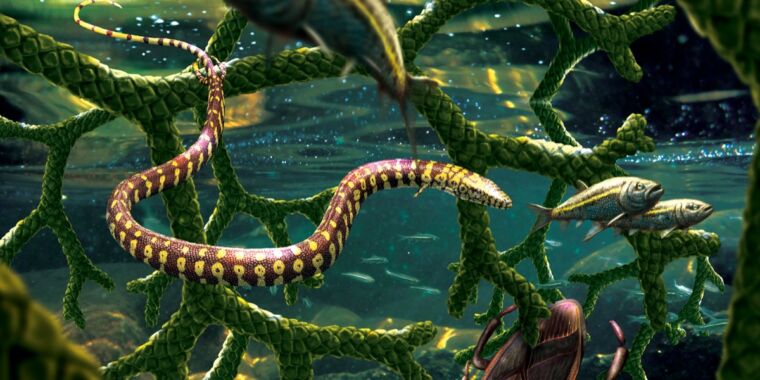
Julius Csotonyi
The discovery of a rare Cretaceous fossil that could have been a missing link in the evolution of modern snakes made headlines in 2015. It was dubbed Tetrapodophis amplectus (“four-footed serpent”) and proved controversial from the start, with some paleontologists questioning the interpretation that it was a protosnake. Now there is strong evidence that this latter view may be the correct one and that the specimen is more likely an early type of lizard, according to a a new paper published in the Journal of Systematic Paleontology.
Paleontologists have long suspected that snakes evolved from lizards at some point in the distant past, gradually losing their limbs. Thus, there should be an evolutionary predecessor with four limbs. This prediction was bolstered in 2006 with the discovery of a transitional snake-like fossil (Najash rionegrina) with two hind limbs dating back some 95 million years. There is also an ongoing debate about whether snakes originated in a marine or terrestrial environment, and the 2006 fossil supported the latter hypothesis.
Then, in 2015, the University of Portsmouth’s David Martill and co-author Nicholas Longrich of the University of Bath published a description of a four-legged fossil they claimed was the first known example of a four-legged protosnake with forelimbs and hindlimbs in the fossil record. Martill had stumbled across the fossil at the Museum Solnhofen in Germany, part of a larger exhibition of fossils from the Cretaceous Period.
According to Martill, the fossil had many known characteristics of a snake, except for its tiny arms and legs, each featuring oddly long fingers and toes that would have been useful for burrowing—more evidence bolstering the case for a terrestrial origin. It featured 160 spinal vertebrae and another 112 vertebrae in the cylindrical (as opposed to flattened) tail. There were also scales stretching across the belly, an elongated body, sharp hooked teeth, and a skull (about the size of a human fingernail) with a short snout and long braincase. Bones of another animal in the gut hinted that the creature was likely carnivorous.
While some paleontologists hailed the find as extraordinary, others voiced skepticism, most notably Michael Caldwell of the University of Alberta in Edmonton, Canada, co-author of this latest paper. At the time, he pointed out that most known snakes and lizards have vertebrae with concave front surfaces and convex rear surfaces, but this did not seem to be the case with Tetrapodophis. The specimen’s vertebrae also seemed to be lacking a small bone called an intercentrum. Caldwell suggested that Tetrapodophis more likely belonged to another large group of amphibians that went extinct roughly 251 million years ago.

Michael Caldwell
Caldwell presented a formal rebuttal at the 2016 meeting of the Society of Vertebrate Paleontology (SVP), drawing on his further observations of the slab of rock that contained the fossil, which constituted a natural mold. This gave him a clearer view of the skull in particular, since that mold preserved several features that were not visible in the original study. As Science reported at the time, “in snake skulls, a bone called the quadrate is elongated, which allows snakes to open their jaws very wide. This fossil’s quadrate bone is more C-shaped, and it surrounds the animal’s hearing apparatus—a characteristic feature of a group of lizards called squamates.”
There was an additional wrinkle to the story that further fueled controversy. Questions had already been raised about the fossil’s provenance. Its composition was consistent with having been excavated from limestone quarries in Brazil, much of which occurred in the latter half of the 20th century. However, Brazilian laws passed in the 1940s made any fossils recovered the property of the state, and it was unclear how the specimen had found its way to Museum Solnhofen.
And when Caldwell contacted the museum to gain access to the fossil for further study, his request was declined. The specimen turned out to belong to a private collector and had merely been on loan to the museum. The owner had removed the fossil after it was damaged during CT scanning at the European Synchrotron Radiation Facility in Germany. Some researchers thought this made further study of Tetrapodophis scientifically moot, since any findings would be untestable if the fossil remained inaccessible.








